MP4 實際代表的含義是 `MPEG-4 Part 14`。它只是 `MPEG` 標準中的 14 部分。它主要參考 `ISO/IEC` 標準來制定的。MP4 主要作用是可以實現快進快放,邊下載邊播放的效果。他是基于 `MOV`,然后發展成自己相關的格式內容。然后和 MP4 相關的文件還有:`3GP`,`M4V` 這兩種格式。
MP4 的格式稍微比 FLV 復雜一些,它是通過嵌的方式來實現整個數據的攜帶。換句話說,它的每一段內容,都可以變成一個對象,如果需要播放的話,只要得到相應的對象即可。
MP4 中最基本的單元就是 Box,它內部是通過一個一個獨立的 box 拼接而成的。所以,這里,我們先從 Box 的講解開始。
> PS:作為一個前端開發,在大部分場合了解 MP4 非但沒用,而且有點浪費時間。本文推薦閱讀是針對音視頻開發感興趣的同學,特別是從事直播,或者,視頻播放器業務相關的開發者。
## MP4 box
MP4 box 可以分為 basic box 和 full box。
* basic box: 主要針對的是相關的基礎 box。比如 ftyp,moov 等。
* full box: 主要針對視頻源的 media box。
這里,再次強調一下,MP4 box 是 MP4 box 的核心。在 decode/encode 過程中,最好把它的基本格式背下來,這樣,你寫起來會開心很多(經驗之談)。
OK,我們來看一下,Box 的具體結構。
### basic box
首先來看一下 basic box 的結構:
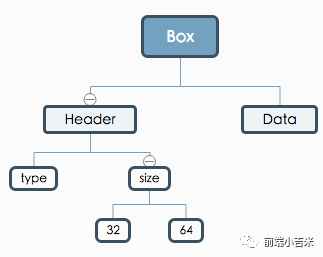
如果用代碼來表示就是:
~~~javascript
aligned(8) class Box (unsigned int(32) boxtype, optional unsigned int(8)[16] extended_type) { unsigned int(32) size; unsigned int(32) type = boxtype; if (size==1) { unsigned int(64) largesize;
} else if (size==0) { // box extends to end of file
} // 這里針對的是 MP4 extension 的盒子類型。一般不會發生
if (boxtype==‘uuid’) { unsigned int(8)[16] usertype = extended_type;
}
}
~~~
上面代碼其實已經說的很清楚了。這里,我在簡單的闡述一下。
* size\[4B\]: 用來代指該 box 的大小,包括 header 和 body。由于其大小有限制,有可能不滿足超大的 box。所以,這里有一個判斷邏輯,當 `size===1` 時,會出現一個 8B 的 `largesize` 字段來存放大小。當 `size===0` 時,表示文件的結束。
* type\[4B\]: 用來標識該 box 的類型,其實內容很簡單,就是直接取指定盒子的英文字母的 ASCII 碼。因為 boxname 的長度只有 4 個字母,所以,只需要通過 `charCodeAt` API 獲取 4 次即可。
~~~javascript
// 獲得指定 box 的 type 字段內容
val.charCodeAt(0)
val.charCodeAt(1)
val.charCodeAt(2)
val.charCodeAt(3)
~~~
實際整個盒子的結構可以用下圖來表示:

這里需要強調的一點就是,在 MP4 中,默認寫入字節序都是 Big-Endian 。所以,在上面,涉及到 4B 8B 等字段內容時,都是以 BE 來寫入的。
上面不是說了,box 有兩種基本格式嗎?
還有一種為 fullBox
### full box
full box 和 box 的主要區別是增加了 version 和 flag 字段。它的應用場景不高,主要是在 `trak` box 中使用。它的基本格式為:
~~~javascript
aligned(8) class FullBox(unsigned int(32) boxtype, unsigned int(8) v, bit(24) f) extends Box(boxtype) {
unsigned int(8) version = v;
bit(24) flags = f;
}
~~~
在實操中,如果你的沒有針對 version 和 flags 的業務場景,那么基本上就可以直接設為默認值,比如 0x00。它的基本結構圖為:

在實際 remux 中,會以 `box` 為最小組合單位,來完成相關的 remux 過程。比如,這里以 JS 來完成最小基本 box 的構造:
~~~javascript
MP4.box = function (type) {
let boxLength = 8; // include the total 8 byte length of size and type
let buffers = Array.prototype.slice.call(arguments, 1);
buffers.forEach(val => { boxLength += val.byteLength; });
let boxBuffer = new Uint8Array(boxLength); // the first four byte stands for boxLength boxBuffer[0] = (boxLength >> 24) & 0xff;
boxBuffer[1] = (boxLength >> 16) & 0xff;
boxBuffer[2] = (boxLength >> 8) & 0xff;
boxBuffer[3] = boxLength & 0xff;
// the second four byte is box's type boxBuffer.set(type, 4);
let offset = 8; // the byteLength of type and size
buffers.forEach(val => { boxBuffer.set(val, offset);
offset += val.byteLength; })
return boxBuffer;}
~~~
上述,通常的調用方法為:
~~~javascript
// MP4.symbolValue.FTYP 為某一個具體的 BufferMP4.box(MP4.types.ftyp, MP4.symbolValue.FTYP);
~~~
接下來,我們就要正式的來看一下,MP4 中真正用到的一些 Box 了。
這里,我們按照 MP4 box 的劃分來進行相關的闡述。先看一張 MP4 給出的結構圖:
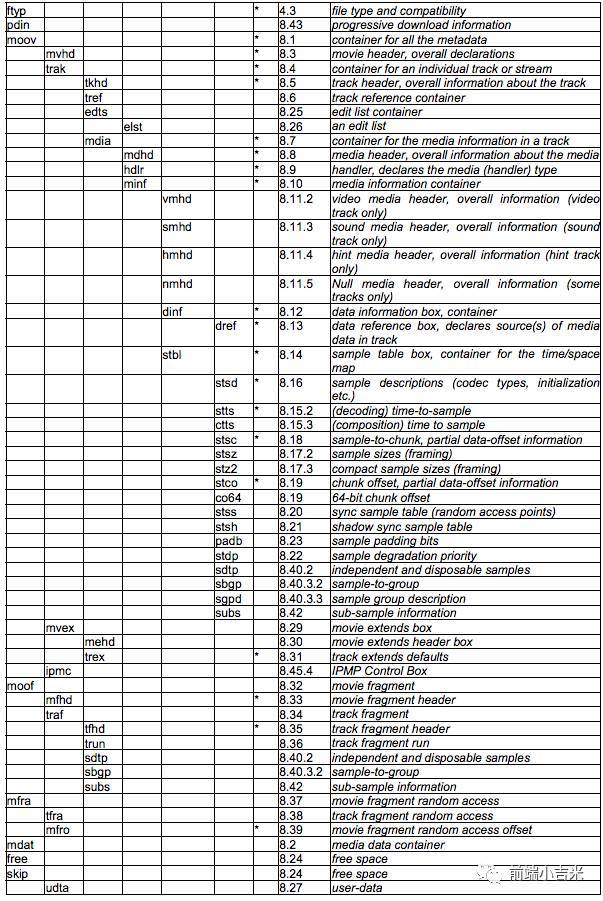
說明一下,我們只講帶星號的 box。其他的因為不是必須 box,我們就選擇性的忽略了。不過,里面帶星號的 Box 還是挺多的。因為,我們的主要目的是為了生成一個 MP4 文件。一個正常的 MP4 文件的結構并不是所有帶星號的 Box 都必須有。
正常播放的 MP4 文件其實還可以分為 unfragmented MP4(簡寫為 MP4) 和 fragmented MP4(簡寫為 FMP4)。那這兩者具體有什么區別呢?
可以說,完全不同。因為他們本身確定 media stream 播放的方式都是完全不同的模式。
.
**MP4 格式**
基本 box 為:
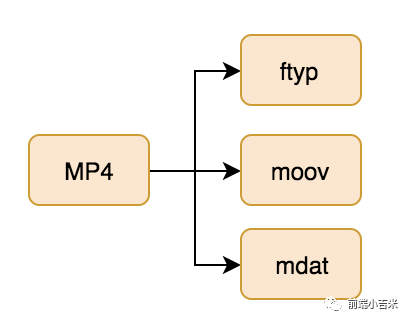
上面這是最基本的 MP4 Box 內容。 較完整的為:
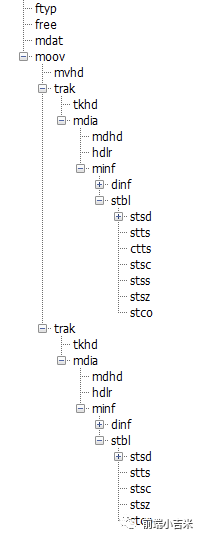
MP4 box 根據 trak 中的 stbl 下的 stts stsc 等基本 box 來完成在 mdat box 中的索引。那 FMP4 是啥呢?
* 非標:非標常用于生成單一 trak 的文件。
* ftyp
* moov
* moof
* mdat
* 標準:用來生成含有多個 trak 的文件。
* ftyp
* moov
* mdat
看起來非標還多一個 box。但在具體編解碼的時候,標準解碼需要更多關注在如何編碼 stbl 下的幾個子 box--stts,stco,ctts 等盒子。而非標不需要關注 stbl,只需要將本來處于 stbl 的數據直接抽到 moof 中。并且在轉換過程中,moof 里面的格式相比 stbl 來說,是非常簡單的。所以,這里,我們主要圍繞上面兩種的標準,來講解對應的 Box。
## 標準 MP4 盒子
### ftyp
ftyp 盒子相當于就是該 mp4 的綱領性說明。即,告訴解碼器它的基本解碼版本,兼容格式。簡而言之,就是用來告訴客戶端,該 MP4 的使用的解碼標準。通常,ftyp 都是放在 MP4 的開頭。
它的格式為:
~~~javascript
aligned(8) class FileTypeBox extends Box(‘ftyp’) { unsigned int(32) major_brand; unsigned int(32) minor_version; unsigned int(32) compatible_brands[];
}
~~~
上面的字段一律都是放在 `data` 字段中(參考,box 的描述)。
* major\_brand: 因為兼容性一般可以分為推薦兼容性和默認兼容性。這里 major\_brand 就相當于是推薦兼容性。通常,在 Web 中解碼,一般而言都是使用 `isom` 這個萬金油即可。如果是需要特定的格式,可以自行定義。
* minor\_version: 指最低兼容版本。
* compatible\_brands: 和 major\_brand 類似,通常是針對 MP4 中包含的額外格式,比如,AVC,AAC 等相當于的音視頻解碼格式。
說這么多概念,還不如給代碼實在。這里,我們可以來看一下,對于通用 ftyp box 的創建。
~~~javascript
FTYP: new Uint8Array([ 0x69, 0x73, 0x6F, 0x6D, // major_brand: isom
0x0, 0x0, 0x0, 0x1, // minor_version: 0x01
0x69, 0x73, 0x6F, 0x6D, // isom
0x61, 0x76, 0x63, 0x31 // avc1
])
~~~
### moov
moov box 主要是作為一個很重要的容器盒子存在的,它本身的實際內容并不重要。moov 主要是存放相關的 trak 。其基本格式為:
~~~javascript
aligned(8) class MovieExtendsBox extends Box(‘mvex’){ }
~~~
### mvhd
mvhd 是 moov 下的第一個 box,用來描述 media 的相關信息。其基本內容為:
~~~javascript
aligned(8) class MovieHeaderBox extends FullBox(‘mvhd’, version, 0) {
if (version==1) {
unsigned int(64) creation_time;
unsigned int(64) modification_time;
unsigned int(32) timescale;
unsigned int(64) duration;
} else { // version==0
unsigned int(32) creation_time;
unsigned int(32) modification_time;
unsigned int(32) timescale;
unsigned int(32) duration;
}
template int(32) rate = 0x00010000; // typically 1.0template int(16) volume = 0x0100; // typically, full volumeconst bit(16) reserved = 0;
const unsigned int(32)[2] reserved = 0;
template int(32)[9] matrix =
{ 0x00010000,0,0,0,0x00010000,0,0,0,0x40000000 }; // Unity matrix
bit(32)[6] pre_defined = 0;
unsigned int(32) next_track_ID;
}
~~~
* version: 一般默認為 0。
* creation\_time: 創建的時間。從 1904 年開始算起,用秒來表示。
* timescale: 時間比例。通過該值和 duration 來算出實際時間
* duration: 持續時間,單位是根據 timescale 來決定的。實際時間為:duration/timescale = xx 秒。
* rate: 播放比例。
* volume: 音量大小。0x0100 為最大值。
* matrix: 不解釋。我也不懂
* next\_track\_ID: 需要比當前 trak\_id 最大值還大才行。一般隨便填個很大的值即可。
實際上,mvhd 大部分的值,都可以設為固定值:
~~~javascript
new Uint8Array([ 0x00, 0x00, 0x00, 0x00, // version(0) + flags
0x00, 0x00, 0x00, 0x00, // creation_time
0x00, 0x00, 0x00, 0x00, // modification_time
(timescale >>> 24) & 0xFF, // timescale: 4 bytes
(timescale >>> 16) & 0xFF,
(timescale >>> 8) & 0xFF,
(timescale) & 0xFF,
(duration >>> 24) & 0xFF, // duration: 4 bytes
(duration >>> 16) & 0xFF,
(duration >>> 8) & 0xFF,
(duration) & 0xFF, 0x00, 0x01, 0x00, 0x00, // Preferred rate: 1.0
0x01, 0x00, 0x00, 0x00, // PreferredVolume(1.0, 2bytes) + reserved(2bytes)
0x00, 0x00, 0x00, 0x00, // reserved: 4 + 4 bytes
0x00, 0x00, 0x00, 0x00, 0x00, 0x01, 0x00, 0x00, // ----begin composition matrix----
0x00, 0x00, 0x00, 0x00, 0x00, 0x00, 0x00, 0x00, 0x00, 0x00, 0x00, 0x00, 0x00, 0x01, 0x00, 0x00, 0x00, 0x00, 0x00, 0x00, 0x00, 0x00, 0x00, 0x00, 0x00, 0x00, 0x00, 0x00, 0x40, 0x00, 0x00, 0x00, // ----end composition matrix----
0x00, 0x00, 0x00, 0x00, // ----begin pre_defined 6 * 4 bytes----
0x00, 0x00, 0x00, 0x00, 0x00, 0x00, 0x00, 0x00, 0x00, 0x00, 0x00, 0x00, 0x00, 0x00, 0x00, 0x00, 0x00, 0x00, 0x00, 0x00, // ----end pre_defined 6 * 4 bytes----
0xFF, 0xFF, 0xFF, 0xFF // next_track_ID
]);
~~~
*****
## trak
trak box 就是主要存放相關 media stream 的內容。其基本格式很簡單就是簡單的 box:
~~~javascript
aligned(8) class TrackBox extends Box(‘trak’) { }
~~~
不過,有時候里面也可以帶上該 media stream 的相關描述:
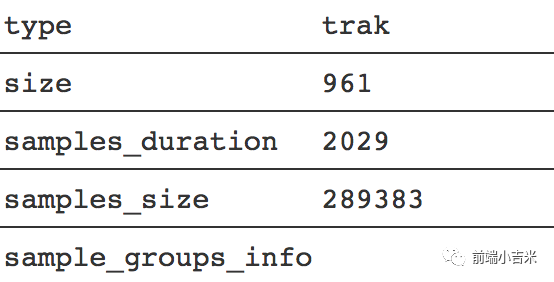
### tkhd
tkhd 是 trak box 的子一級 box 的內容。主要是用來描述該特定 trak 的相關內容信息。其主要內容為:
~~~javascript
aligned(8) class TrackHeaderBox
extends FullBox(‘tkhd’, version, flags){ if (version==1) { unsigned int(64) creation_time; unsigned int(64) modification_time; unsigned int(32) track_ID; const unsigned int(32) reserved = 0; unsigned int(64) duration;
} else { // version==0
unsigned int(32) creation_time; unsigned int(32) modification_time; unsigned int(32) track_ID; const unsigned int(32) reserved = 0; unsigned int(32) duration;
}const unsigned int(32)[2] reserved = 0;template int(16) layer = 0;template int(16) alternate_group = 0;template int(16) volume = {if track_is_audio 0x0100 else 0};
const unsigned int(16) reserved = 0;template int(32)[9] matrix=
{ 0x00010000,0,0,0,0x00010000,0,0,0,0x40000000 }; // unity matrix
unsigned int(32) width; unsigned int(32) height;
}
~~~
上面內容確實挺多的,但是,有些并不是一定需要填一些合法值。這里簡單說明一下:
* creation\_time: 創建時間,非必須
* modification\_time: 修改時間,非必須
* track\_ID: 指明當前描述的 track ID。
* duration: 當前 track 內容持續的時間。通常結合 timescale 進行相關計算。
* layer: 沒啥用。通常用來作為分成 video trak 的使用。
* alternate\_group: 可替換 track 源。如果為 0 表示當前 track 沒有指定的 track 源替代。非 0 的話,則表示存在多個源的 group。
* volume: 用來確定音量大小。滿音量為 1(0x0100)。
* width and height:確定視頻的寬高
### mdia
mdia 主要用來包裹相關的 media 信息。本身沒啥說的,格式為:
~~~javascript
aligned(8) class MediaBox extends Box(‘mdia’) { }
~~~
### mdhd
mdhd 和 tkhd 來說,內容大致都是一樣的。不過,tkhd 通常是對指定的 track 設定相關屬性和內容。而 mdhd 是針對于獨立的 media 來設置的。不過事實上,兩者一般都是一樣的。
具體格式為:
~~~javascript
aligned(8) class MediaHeaderBox extends FullBox(‘mdhd’, version, 0) { if (version==1) { unsigned int(64) creation_time; unsigned int(64) modification_time; unsigned int(32) timescale; unsigned int(64) duration;
} else { // version==0
unsigned int(32) creation_time; unsigned int(32) modification_time; unsigned int(32) timescale; unsigned int(32) duration;
}bit(1) pad = 0;unsigned int(5)[3] language; // ISO-639-2/T language code unsigned int(16) pre_defined = 0;}
~~~
里面就有 3 個額外的字段:pad,language,pre\_defined。
根據字面意思很好理解:
* pad: 占位符,通常為 0
* language: 表明當前 trak 的語言。因為該字段總長為 15bit,通常是和 pad 組合成為 2B 的長度。
* pre\_defined: 默認為 0.
實際代碼的計算方式為:
~~~javascript
new Uint8Array([ 0x00, 0x00, 0x00, 0x00, // version(0) + flags
0x00, 0x00, 0x00, 0x00, // creation_time
0x00, 0x00, 0x00, 0x00, // modification_time
(timescale >>> 24) & 0xFF, // timescale: 4 bytes
(timescale >>> 16) & 0xFF,
(timescale >>> 8) & 0xFF,
(timescale) & 0xFF,
(duration >>> 24) & 0xFF, // duration: 4 bytes
(duration >>> 16) & 0xFF,
(duration >>> 8) & 0xFF,
(duration) & 0xFF, 0x55, 0xC4, // language: und (undetermined)
0x00, 0x00 // pre_defined = 0
])
~~~
### hdlr
hdlr 是用來設置不同 trak 的處理方式的。常用處理方式如下:
* vide : Video track
* soun : Audio track
* hint : Hint track
* meta : Timed Metadata track
* auxv : Auxiliary Video track
這個,其實就和我們在得到和接收到資源時,設置的 `Content-Type` 類型字段是一致的,例如 `application/javascript`。
其基本格式為:
~~~javascript
aligned(8) class HandlerBox extends FullBox(‘hdlr’, version = 0, 0) {
unsigned int(32) pre_defined = 0;
unsigned int(32) handler_type;
const unsigned int(32)[3] reserved = 0;
string name;
}
~~~
其中有兩字段需要額外說明一下:
* handler\_type:是代指具體 trak 的處理類型。也就是我們上面列寫的 vide,soun,hint 字段。
* name: 是用來寫名字的。其主要不是給機器讀的,而是給人讀,所以,這里你只要覺得能表述清楚,填啥其實都行。
handler\_type 填的值其實就是 string 轉換為 hex 之后得到的值。比如:
* vide 為 `0x76, 0x69, 0x64, 0x65`
* soun 為 `0x73, 0x6F, 0x75, 0x6E`
### minf
minf 是子屬內容中,重要的容器 box,用來存放當前 track 的基本描述信息。本身沒啥說的,基本格式為:
~~~javascript
aligned(8) class MediaInformationBox extends Box(‘minf’) { }
~~~
### v/smhd
v/smhd 是對當前 trak 的描述 box。vmhd 針對的是 video,smhd 針對的是 audio。這兩個盒子在解碼中,非不可或缺的(有時候得看播放器),缺了的話,有可能會被認為格式不正確。
我們先來看一下 vmhd 的基本格式:
~~~javascript
aligned(8) class VideoMediaHeaderBox
extends FullBox(‘vmhd’, version = 0, 1) {
template unsigned int(16) graphicsmode = 0; // copy, see below template unsigned int(16)[3] opcolor = {0, 0, 0};
}
~~~
這很簡單都是一些默認值,我這里就不多說了。
smhd 的格式同樣也很簡單:
~~~javascript
aligned(8) class SoundMediaHeaderBox
extends FullBox(‘smhd’, version = 0, 0) { template int(16) balance = 0; const unsigned int(16) reserved = 0;
}
~~~
其中,balance 這個字段相當于和我們通常設置的左聲道,右聲道有關。
* balance: 該值是一個浮點值,0 為 center,1.0 為 right,-1.0 為 left。
### dinf
dinf 是用來說明在 trak 中,media 描述信息的位置。其實本身就是一個容器,沒啥內容:
~~~javascript
aligned(8) class DataInformationBox extends Box(‘dinf’) { }
~~~
### dref
dref 是用來設置當前 Box 描述信息的 data\_entry。基本格式為:
~~~javascript
aligned(8) class DataReferenceBox
extends FullBox(‘dref’, version = 0, 0) {
unsigned int(32) entry_count; for (i=1; i <= entry_count; i++) {
DataEntryBox(entry_version, entry_flags) data_entry; }
}
~~~
其中的 DataEntryBox 就是 DataEntryUrlBox/DataEntryUrnBox 中的一個。簡單來說,就是 dref 下的子 box -- `url` 或者 `urn` 這兩個 box。其中,entry\_version 和 entry\_flags 需要額外說明一下。
* entry\_version: 用來指明當前 entry 的格式
* entry\_flags: 其值不是固定的,但是有一個特殊的值, 0x000001 用來表示當前 media 的數據和 moov 包含的數據一致。
不過,就通常來說,我真的沒有用到過有實際數據的 dref 。所以,這里就不衍生來講了。
### url
url box 是由 dref 包裹的子一級 box,里面是對不同的 sample 的描述信息。不過,一般都是附帶在其它 box 里。其基本格式為:
~~~javascript
aligned(8) class DataEntryUrlBox (bit(24) flags) extends FullBox(‘url ’, version = 0, flags) {
string location;
}
~~~
實際并沒有用到過 `location` 這個字段,所以,一般也就不需要了。
### stts
stts 主要是用來存儲 refSampleDelta。即,相鄰兩幀間隔的時間。它基本格式為:
~~~javascript
aligned(8) class TimeToSampleBox
extends FullBox(’stts’, version = 0, 0) { unsigned int(32) entry_count; int i; for (i=0; i < entry_count; i++) { unsigned int(32) sample_count; unsigned int(32) sample_delta;
}
}
~~~
看代碼其實看不出什么,我們結合實際抓包結果,來講解。現有如下的幀:

可以看到,上面的 Decode delta 值都是 10。這就對應著 sample\_delta 的值。而 sample\_count 就對應出現幾次的 sample\_delta。比如,上面 10 的 delta 出現了 14 次,那么 sample\_count 就是 14。
如果對應于 RTMP 中的 Video Msg,那么 sample\_delta 就是當前 RTMP Header 中,后面一個的 timeStamp delta。
### stco
stco 是 stbl 包里面一個非常關鍵的 Box。它用來定義每一個 sample 在 mdat 具體的位置。基本格式為:
~~~javascript
aligned(8) class ChunkOffsetBox
extends FullBox(‘stco’, version = 0, 0) {
unsigned int(32) entry_count;for (i=1; i u entry_count; i++) { unsigned int(32) chunk_offset;
}
}
~~~
具體可以參考:

stco 有兩種形式,如果你的視頻過大的話,就有可能造成 chunkoffset 超過 32bit 的限制。所以,這里針對大 Video 額外創建了一個 co64 的 Box。它的功效等價于 stco,也是用來表示 sample 在 `mdat` box 中的位置。只是,里面 chunk\_offset 是 64bit 的。
~~~javascript
aligned(8) class ChunkLargeOffsetBox extends FullBox(‘co64’, version = 0, 0) {
unsigned int(32) entry_count;for (i=1; i u entry_count; i++) {
unsigned int(64) chunk_offset;
}
}
~~~
### stsc
stsc 這個 Box 有點繞,并不是它的字段多,而是它的字段意思有點奇怪。其基本格式為:
~~~javascript
aligned(8) class SampleToChunkBox
extends FullBox(‘stsc’, version = 0, 0) {
unsigned int(32) entry_count; for (i=1; i u entry_count; i++) { unsigned int(32) first_chunk; unsigned int(32) samples_per_chunk;
unsigned int(32) sample_description_index;
}
}
~~~
關鍵點在于他們里面的三個字段: `first_chunk`,`samples_per_chunk`,`sample_description_index`。
* first\_chunk: 每一個 entry 開始的 chunk 位置。
* samples\_per\_chunk: 每一個 chunk 里面包含多少的 sample
* sample\_description\_index: 每一個 sample 的描述。一般可以默認設置為 1。
這 3 個字段實際上決定了一個 MP4 中有多少個 chunks,每個 chunks 有多少個 samples。這里順便普及一下 chunk 和 sample 的相關概念。在 MP4 文件中,最小的基本單位是 `Chunk` 而不是 `Sample`。
* sample: 包含最小單元數據的 slice。里面有實際的 NAL 數據。
* chunk: 里面包含的是一個一個的 sample。為了是優化數據的讀取,讓 I/O 更有效率。
看了上面字段就懂得,感覺你要么是大牛,要么就是在裝逼。官方文檔和上面一樣的描述,但是,看了一遍后,懵逼,再看一遍后,懵逼。所以,這里為了大家更好的理解,這里額外再補充一下。
前面說了,在 MP4 中最小的單位是 chunks,那么通過 stco 中定義的 chunk\_offsets 字段,它描述的就是 chunks 在 mdat 中的位置。每一個 stco chunk\_offset 就對應于 某一個 index 的 chunks。那么,`first_chunk` 就是用來定義該 chunk entry 開始的位置。
那這樣的話,stsc 需要對每一個 chunk 進行定義嗎?
不需要,因為 stsc 是定義一整個 entry,即,如果他們的 `samples_per_chunk`,`sample_description_index` 不變的話,那么后續的 chunks 都是用一樣的模式。
即,如果你的 stsc 只有:
* first\_chunk: 1
* samples\_per\_chunk: 4
* sample\_description\_index: 1
也就是說,從第一個 chunk 開始,每通過切分 4 個 sample 劃分為一個 chunk,并且每個 sample 的表述信息都是 1。它會按照這樣劃分方法一直持續到最后。當然,如果你的 sample 最后不能被 4 整除,最后的幾段 sample 就會當做特例進行處理。
通常情況下,stsc 的值是不一樣的:

按照上面的情況就是,第 1 個 chunk 包含 2 個 samples。第 2-4 個 chunk 包含 1 個 sample,第 5 個 chunk 包含兩個 chunk,第 6 個到最后一個 chunk 包含一個 sample。
### ctts
ctts 主要針對 Video 中的 B 幀來確定的。也就是說,如果你視頻里面沒有 B 幀,那么,ctts 的結構就很簡單了。它主要的作用,是用來記錄每一個 sample 里面的 cts。格式為:
~~~javascript
aligned(8) class CompositionOffsetBox extends FullBox(‘ctts’, version = 0, 0) {
unsigned int(32) entry_count;
int i; for (i=0; i < entry_count; i++) {
unsigned int(32) sample_count;
unsigned int(32) sample_offset;
}
}
~~~
還是看實例吧,假如你視頻中幀的排列如下:

其中,sample\_offset 就是 Composition offset。通過合并一致的 Composition offset,可以得到對應的 sample\_count。最終 ctts 的結果為:

看實例抓包的結果為:
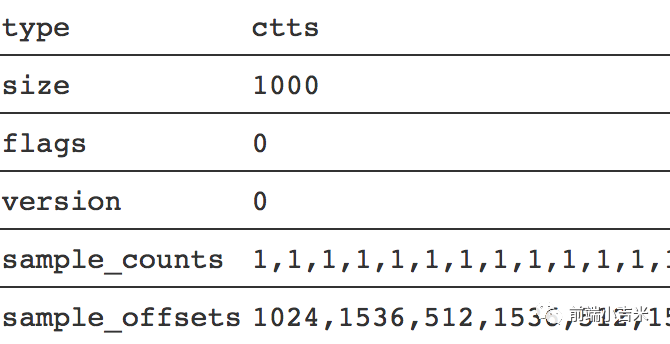
如果,你是針對 RTMP 的 video,由于,其沒有 B 幀,那么 ctts 的整個結果,就只有一個 sample\_count 和 sample\_offset。比如:
~~~javascript
sample_count: 100sample_offset: 0
~~~
通常只有 video track 才需要 ctts。
### stsz
stsz 是用來存放每一個 sample 的 size 信息的。基本格式為:
~~~javascript
aligned(8) class SampleSizeBox extends FullBox(‘stsz’, version = 0, 0) {
unsigned int(32) sample_size;
unsigned int(32) sample_count;if (sample_size==0) { for (i=1; i <= sample_count; i++) {
unsigned int(32) entry_size;
}
}
}
~~~
這個沒啥說的,就是所有 sample 的 size 大小,以及相應的描述信息。
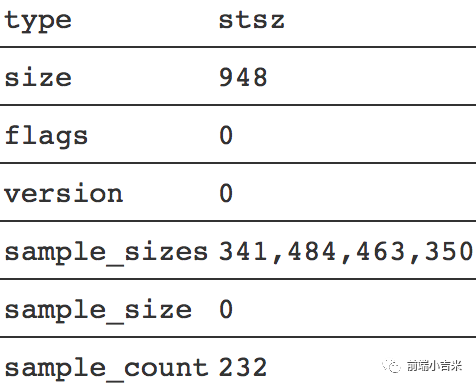
## fragmented MP4
前面部分是標準 box 的所有內容。當然,fMP4 里面大部分內容和 MP4 標準格式有很多重復的地方,剩下的就不過多贅述,只把不同的單獨挑出來講解。
### mvex
mvex 是 fMP4 的標準盒子。它的作用是告訴解碼器這是一個 fMP4 的文件,具體的 samples 信息內容不再放到 trak 里面,而是在每一個 moof 中。基本格式為:
~~~javascript
aligned(8) class MovieExtendsBox extends Box(‘mvex’){ }
~~~
### trex
trex 是 mvex 的子一級 box 用來給 fMP4 的 sample 設置默認值。基本內容為:
~~~javascript
aligned(8) class TrackExtendsBox extends FullBox(‘trex’, 0, 0){
unsigned int(32) track_ID;
unsigned int(32) default_sample_description_index;
unsigned int(32) default_sample_duration;
unsigned int(32) default_sample_size;
unsigned int(32) default_sample_flags
}
~~~
具體設哪一個值,這得看你業務里面具體的要求才行。 如果實在不知道,那就可以直接設置為 0:
~~~javascript
new Uint8Array([ 0x00, 0x00, 0x00, 0x00, // version(0) + flags
(trackId >>> 24) & 0xFF, // track_ID
(trackId >>> 16) & 0xFF,
(trackId >>> 8) & 0xFF,
(trackId) & 0xFF, 0x00, 0x00, 0x00, 0x01, // default_sample_description_index
0x00, 0x00, 0x00, 0x00, // default_sample_duration
0x00, 0x00, 0x00, 0x00, // default_sample_size
0x00, 0x01, 0x00, 0x01 // default_sample_flags
])
~~~
### moof
moof 主要是用來存放 FMP4 的相關內容。它本身沒啥太多的內容:
~~~javascript
aligned(8) class TrackFragmentBox extends Box(‘traf’){
}
~~~
### tfhd
tfhd 主要是對指定的 trak 進行相關的默認設置。例如:sample 的時長,大小,偏移量等。不過,這些都可以忽略不設,只要你在其它 box 里面設置完整即可:
~~~javascript
aligned(8) class TrackFragmentHeaderBox extends FullBox(‘tfhd’, 0, tf_flags){ unsigned int(32) track_ID;// all the following are optional fields
unsigned int(64) base_data_offset; unsigned int(32) sample_description_index; unsigned int(32) default_sample_duration; unsigned int(32) default_sample_size; unsigned int(32) default_sample_flags
}
~~~
base\_data\_offset 是用來計算后面數據偏移量用到的。如果存在則會用上,否則直接是相關開頭的偏移。
### tfdt
tfdt 主要是用來存放相關 sample 編碼的絕對時間的。因為 FMP4 是流式的格式,所以,不像 MP4 一樣可以直接根據 sample 直接 seek 到具體位置。這里就需要一個標準時間參考,來快速定位都某個具體的 fragment。
它的基本格式為:
~~~javascript
aligned(8) class TrackFragmentBaseMediaDecodeTimeBox extends FullBox(‘tfdt’, version, 0) {if (version==1) {
unsigned int(64) baseMediaDecodeTime;
} else { // version==0
unsigned int(32) baseMediaDecodeTime;
}
}
~~~
baseMediaDecodeTime 基本值是前面所有指定 trak\_id 中 samples 持續時長的總和,相當于就是當前 traf 里面第一個 sample 的 dts 值。
### trun
trun 存儲該 moof 里面相關的 sample 內容。例如,每個 sample 的 size,duration,offset 等。基本內容為:
~~~javascript
aligned(8) class TrackRunBox extends FullBox(‘trun’, version, tr_flags) {unsigned int(32) sample_count;// the following are optional fieldssigned int(32) data_offset;unsigned int(32) first_sample_flags;// all fields in the following array are optional {
unsigned int(32) sample_duration; unsigned int(32) sample_size; unsigned int(32) sample_flags if (version == 0)
{ unsigned int(32) sample_composition_time_offset else
{ signed int(32) sample_composition_time_offset
}[ sample_count ]
}
~~~
可以說,trun 上面的字段是 traf 里面最重要的標識字段:
tr\_flags 是用來表示下列 sample 相關的標識符是否應用到每個字段中:
* 0x000001: data-offset-present,只應用 data-offset
* 0x000004: 只對第一個 sample 應用對應的 flags。剩余 sample flags 就不管了。
* 0x000100: 這個比較重要,表示每個 sample 都有自己的 duration,否則使用默認的
* 0x000200: 每個 sample 有自己的 sample\_size,否則使用默認的。
* 0x000400: 對每個 sample 使用自己的 flags。否則,使用默認的。
* 0x000800: 每個 sample 都有自己的 cts 值
后面字段,我們這簡單介紹一下。
* data\_offset: 用來表示和該 moof 配套的 mdat 中實際數據內容距 moof 開頭有多少 byte。相當于就是 moof.byteLength + mdat.headerSize。
* sample\_count: 一共有多少個 sample
* first\_sample\_flags: 主要針對第一個 sample。一般來說,都可以默認設為 0。
后面的幾個字段,我就不贅述了,對了,里面的 sample\_flags 是一個非常重要的東西,常常用它來表示,到底哪一個 sampel 是對應的 keyFrame。基本計算方法為:
~~~javascript
(flags.isLeading << 2) | flags.dependsOn, // sample_flags(flags.isDepended << 6) | (flags.hasRedundancy << 4) | flags.isNonSync
~~~
### sdtp
sdtp 主要是用來描述具體某個 sample 是否是 I 幀,是否是 leading frame 等相關屬性值,主要用來作為當進行點播回放時的同步參考信息。其內容一共有 4 個:
* is\_leading:是否是開頭部分。
* 0: 當前 sample 的 leading 屬性未知(經常用到)
* 1: 當前 sample 是 leading sample,并且不能被 decoded
* 2: 當前 sample 并不是 leading sample。
* 3: 當前 sample 是 leading sample,并且能被 decoded
* sample\_depends\_on:是否是 I 幀。
* 0: 該 sample 不知道是否依賴其他幀
* 1: 該 sample 是 B/P 幀
* 2: 該 sample 是 I 幀。
* 3: 保留字
* sample\_is\_depended\_on: 該幀是否被依賴
* 0: 不知道是否被依賴,特指(B/P)
* 1: 被依賴,特指 I 幀
* 3: 保留字
* sample\_has\_redundancy: 是否有冗余編碼
* 0: 不知道是否有冗余
* 1: 有冗余編碼
* 2: 沒有冗余編碼
* 3: 保留字
整個基本格式為:
~~~javascript
aligned(8) class SampleDependencyTypeBox extends FullBox(‘sdtp’, version = 0, 0) {
for (i=0; i < sample_count; i++){
unsigned int(2) is_leading;
unsigned int(2) sample_depends_on;
unsigned int(2) sample_is_depended_on;
unsigned int(2) sample_has_redundancy;
}
}
~~~
sdtp 對于 video 來說很重要,因為,其內容字段主要就是給 video 相關的幀設計的。而 audio,一般直接采用默認值:
~~~javascript
isLeading: 0,dependsOn: 1,
isDepended: 0,hasRedundancy: 0
~~~
到這里,整個 MP4 和 fMP4 的內容就已經介紹完了。更詳細的內容可以參考 MP4 & FMP4 doc。
當然,這里只是非常皮毛的一部分,僅僅知道 box 的內容,并不足夠來做一些音視頻處理。更多的是關于音視頻的基礎知識,比如,dts/pts、音視頻同步、視頻盒子的封裝等等
- 序言
- 編解碼
- H264
- HEVC碼流解析
- H264編碼原理
- 多媒體封裝
- MP4
- 學好 MP4,讓直播更給力
- AAC
- FLV
- 流媒體協議
- RTSP
- RTCP
- RTP
- H265 RTP封包筆記
- SDP
- RTMP
- RTMP URL
- rtmp url基礎
- webrtc
- 編譯
- 最簡單的編譯webrtc方案
- Webrtc音視頻會議之Webrtc“不求甚解”
- Webrtc音視頻會議之Mesh/MCU/SFU三種架構
- 音頻傳輸之Jitter Buffer設計與實現
- Janus
- Webrtc音視頻會議之Janus編譯
- Webrtc音視頻會議之Janus源碼架構設計
- webrtc服務器-janus房間管理
- 源碼分析
- WebRTC視頻JitterBuffer詳解
- 走讀Webrtc 中的視頻JitterBuffer(一)
- 走讀webrtc 中的視頻JitterBuffer(二)
- webrtc視頻幀率控制算法機制
- 目標碼率丟幀-1
- 目標幀率丟幀-2
- 29 如何使用Medooze 實現多方視頻會議
- FFmpeg
- FFmpeg編譯
- Window10下編譯最新版FFmpeg的方法步驟
- FFMPEG靜態庫編譯
- ffmpeg實現畫中畫
- FFmpeg推流器
- ffmpeg-aac
- OpenCV
- OpenCV學習筆記——視頻的邊緣檢測
- 圖像特征點匹配(視頻質量診斷、畫面抖動檢測)
- 圖像質量診斷
